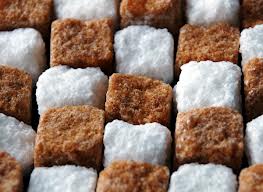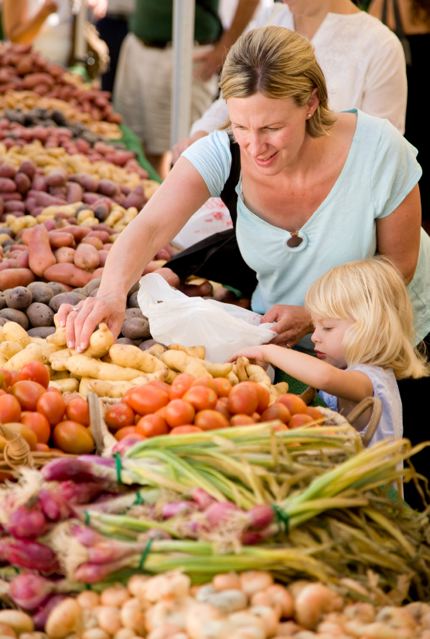Happy New Year! If one of your goals for the coming year is to improve the quality of your family’s food, this is the post for you! Here are 7 great ideas to get you started with healthy changes:
- Download, print, discuss and sign the free 5-A-Day Pledge from my website and start tracking your fruit & veggie intake, aiming for a minimum of 5 a day.
- Post your family members’ signed pledges in your kitchen as a daily reminder. Plants are the basic underpinning of any healthy, real food diet, and most Canadians are not getting the minimum recommended servings, so this is a great place to start getting real. Don’t worry too much about serving sizes, especially for kids. As a general rule for adults, 1 serving of fruit is a piece of whole fruit or a cup of berries or chopped fruit, and one serving of veg is a cup raw or 1/2 c. cooked. Do a chart and start tracking each family member’s intake daily – giving a sticker or a star for every day they get to 5.
- Start reading labels. Can you pronounce and identify the ingredients and imagine where they came from in nature? If they didn’t come from nature, they came from a lab, and probably aren’t things your body was designed to process, and definitely aren’t real food. As we go through the month, I’ll point out some of the worst artificial offenders & provide healthier substitutes, but for now start to become aware as a family of how much “Non food” is in your food. Can you find a simple, real replacement next time you hit the grocery store?
- Ditch the juice & other sugary drinks, and start drinking more water! Most juices, pops and sports’ drinks are full of sugar, artificial sugars or High Fructose Corn Syrup. An 8 oz glass of juice has 2 to 2.5 times the amount sugar in one piece of that fruit, and hardly any of its fibre. The fruit’s fibre is removed when we juice it, so there is nothing to slow down its digestion and the release of its high sugars -it’s like injecting yourself with a syringe of sugar! If you check labels you will also often see loads of other artificial ingredients. The American Pediatric Association recommends no more than 6 oz PER DAY for kids, which is about one standard juice box. Ask your kids if they can make the switch after explaining why the real thing, a piece of fruit, is always better than its processed juice, and pure water is the best drink.
- Start Meal Planning! This is the key to keeping real family food realistic & affordable. Without meal planning, fresh food goes bad, time runs out, and you find yourself at Subway even though you had the best of intentions! Download my free Family Meal Planner, and plan your meals for a week, checking your freezer first to see what you have frozen that you can slot in to the week. The “evening activity” section allows you to pencil in exactly what’s happening in your family’s real life that night – so you can be realistic. Hockey at 5 and dance at 6? You’re not making something from scratch, so make something on the weekend & freeze it or plan a “healthy fast food” meal like leftovers, whole grain pasta & natural tomato sauce, or “breakfast for dinner”. Once you’ve planned your week’s meals, do up a grocery list of everything you need to make it happen. Start small – just plan dinners this week, then build from there.
- Eat more local food. Where does your food come from? Generally speaking,the further it’s travelled, the more has been done to it to keep it from going bad, and the less “real” it is. Are you buying food from other parts of the world that are grown in your own neck of the woods? Locally-grown food is often fresher & more nutrient-dense as it’s spent less time “off the vine”. Every day after a fruit or veg is picked, its nutrient content depletes a little. Local food has also travelled less and therefore creates less pollution from farm to table. And of course, you are supporting your local farmers & economy. Check out your local farmers’ market as a family this month. (Try the Halifax Seaport Farmers Market, Alderney Market or Hammonds Plains Farmers’ Market in the HRM) Find a local food you’ve never cooked with but want to try, bring it home, google a recipe & get going!
- Better your bread. The first step with bread products is to make sure they are 100 % whole grain, which ensures all the goodness, including the fibre and nutrients of the grain, stays in your bread. Caution: “Multigrain”, “Contains Whole Grains” or “Made with the Goodness of Whole Grains” does not mean 100% whole grain – often these breads will have white, enriched wheat or wheat flour (all names for white flour!) as their first or second ingredient. Second step? Read the ingredients. Lots of commercial 100% whole grain breads will have a whole load of ingredients you can’t pronounce that enable them to be shipped across the country and sit on the grocery store shelves for a longer time. There are lots of local bakeries that make delicious breads with way less ingredients, start looking for those in the store or at the market and compare the labels. You’ll be amazed at the difference: 5 or 6 ingredients you can pronounce and recognize v. 15 to 20, many of which you can’t. Can you make the switch to real, 100% whole grain products? YES YOU CAN! My Tip: When you see it at a good price, buy in bulk and freeze.
- Say No to Artificial Colours. Food dyes are in almost everything out there, including some very unlikely places that might surprise you. Certain food dyes have been linked with behavioural changes in children and some children exhibit a more severe reaction. The UK restricts food manufacturers from using a number of artificial colours that we still see on those same manufacturer’s labels in Canada. Start looking at your food and asking yourself and your kids: “Does this colour exist in nature?” If not, it probably came from a lab. Anything that stains your hands or mouth is a no-brainer, but sometimes the dye is hidden where you’d least expect it. Take cheese, for example: milk from the cow is white, but most commercial cheddars are orange. The culprit? Artificial colour. The really simple solution? Buy white cheddar! It’s there, in the deli area or at the market, and it tastes exactly the same, and you’ll recognize all of it’s ingredients. Start checking for colour on labels and looking for an alternative to the products you consistently buy that contain it, and you’ll be one step closer to getting real with your family food.
There you go – 7 ideas to get you started. If you’d like some more, just follow my 30 Days of Real Change Challenge at Facebook.com/SimpleBalance and my blog throughout the month of January!
Happy New Year, Urban Parents!
Wendy McCallum, LLB, RHN, is passionate about providing busy parents with the tools & support they need to feed their families wholesome food, so everyone can play, learn, and feel better! She is a mother of two terrific kids. For information and recipe ideas, visit her website or pick-up her cookbook





